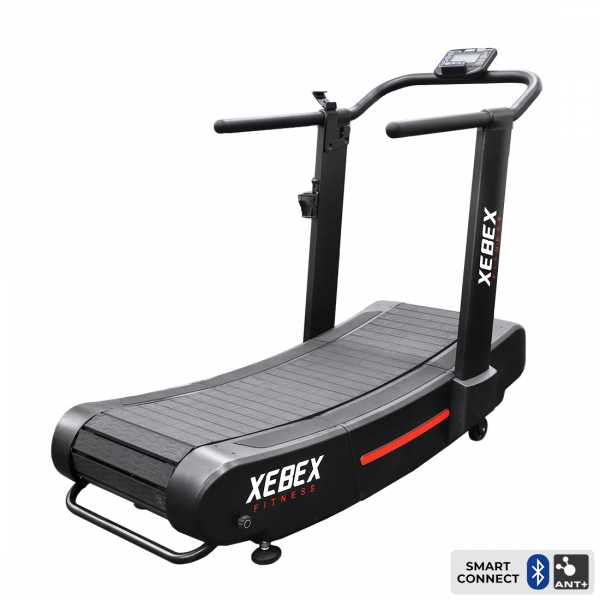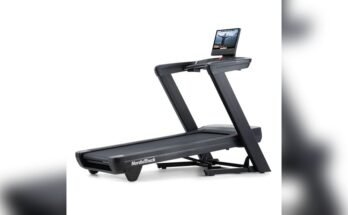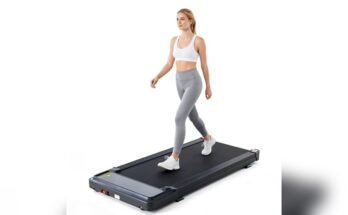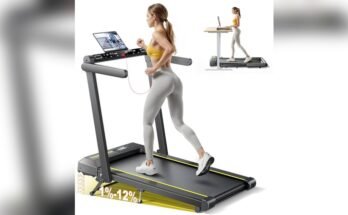Curved treadmills can reduce stress on knees compared to flat treadmills. They encourage a natural running gait which often leads to less joint impact.
Curved treadmills are gaining popularity among fitness enthusiasts and professionals. These innovative machines are designed to mimic the natural movement of running outside. The unique curve of the treadmill offers a manual experience, with no electricity required, which prompts the user to maintain momentum through proper form.
This results in a more engaging workout that not only burns more calories but also reduces the strain on the knees. Unlike traditional flat treadmills, the curved design helps promote a forefoot strike, which is thought to decrease the impact forces that contribute to knee stress. For runners seeking a knee-friendly workout or those rehabilitating from an injury, curved treadmills may offer an effective solution. They serve as a valuable tool for maintaining fitness while also potentially reducing the risk of knee pain.

Credit: www.getrxd.com
Curved Treadmills Vs. Traditional Models
When choosing a treadmill, the design can have a big impact on your workout and your knees. Curved treadmills offer a different experience from the traditional flat treadmills. Let’s explore how they differ, particularly in design and mechanics, and what that means for knee stress.
Design Variations And Their Impact On Running
Curved treadmills boast a unique shape that can change the way you run. Unlike the flat surface of traditional models, the curved platform is designed to follow the natural rolling motion of your feet. This offers a more natural running position, which can potentially be better for your knees.
- Non-motorized movement: It powers up with the runner’s own force.
- Enhanced engagement: The legs and core work harder to maintain momentum.
- Contours to natural foot strike: Mimics outdoor running more closely than flat treadmills.
Mechanical Differences Affecting Joint Stress
How do these machines work, and why might one be kinder to your knees? Traditional treadmills use a motor, which can dictate the pace, possibly leading to unnatural adjustments in your stride. Curved treadmills, being self-powered, allow you to control your stride more naturally, which may reduce stress on your joints.
| Feature | Curved Treadmill | Traditional Treadmill |
|---|---|---|
| Motor | No | Yes |
| Speed Control | User-Powered | Machine-Controlled |
| Knee Impact | Potentially Lower | Varies |
Consider a curved treadmill’s lack of a motor as a plus for knee health. Your body’s natural gait comes into play, promoting healthier movement. This mechanical difference respects the body’s innate mechanics, potentially leading to less joint pain and injury.
Biomechanics Of Running On Curved Treadmills
The biomechanics of running on curved treadmills can be starkly different from traditional flat treadmills. Understanding these differences is key to assessing their impact on knee health. Let’s explore the facets of running that change when you step onto a curved platform.
Foot Strike And Knee Alignment
A curved treadmill prompts a more natural running posture. This leads to changes in foot strike. Unlike flat treadmills, where heel striking prevails, the curve encourages runners to land on their midfoot or forefoot. This shift can lead to better knee alignment, reducing stress on this pivotal joint.
Muscle Engagement And Impact Forces
Running on a curve necessitates greater muscle engagement. This heightened activation not only builds strength but also
can reduce impact forces. As muscles work harder, they absorb more shock, protecting knees from jarring impacts that often occur during running.Knee Health And Exercise Equipment
Considering the right exercise equipment is crucial for knee health. Running and walking are popular exercises, but they can stress knee joints.
A curved treadmill offers a smooth, natural running surface. This design can reduce knee strain. Let’s explore how your knee works and why a curved treadmill may be a gentle choice for knee joints.
Anatomy Of The Knee Joint
The knee is a complex hinge joint. It includes bones, cartilage, and ligaments. A curved treadmill’s design can encourage proper alignment and reduce harmful impact. This equipment helps protect delicate knee components during exercise.
Common Treadmill-related Knee Injuries
- Runner’s Knee: Pain around the kneecap often due to overuse.
- IT Band Syndrome: Inflammation of the ligament that runs outside the thigh.
- Tendonitis: Inflammation of the tendons connecting the knee joint.
Curved treadmills may prevent these injuries. Their curved surface promotes better posture and a softer landing for each step.
Evidence-based Benefits Of Curved Treadmills
Curved treadmills spark interest in fitness circles. Their unique design aims to reduce strain on joints. Unlike flat treadmills, they match natural running mechanics. Let’s delve into scientific studies and personal feedback on their knee-friendly benefits.
Research Findings On Reduced Joint Impact
Studies suggest curved treadmills may be gentler on knees. Their curved surface promotes a more natural foot strike. This leads to a lower impact on joints. Here’s what research says:
- Impact reduction: Curved platforms can lessen force on knees.
- Improved posture: They encourage a straight back and proper gait.
- Calorie burn: Users often burn more calories for the same distance.
Personal Reports And Physiotherapist Endorsements
Users often report less knee pain after switching to curved treadmills. Physiotherapists sometimes recommend them for rehab or lower-impact training. Here’s what they say:
“Clients feel a noticeable difference in their knees. The curved design seems to be easier on their joints.” – Certified Physiotherapist
User testimonials align with expert views. They highlight benefits like:
- Less discomfort: Users often experience a smooth run with less pain.
- Quick recovery: There’s typically less downtime required between runs.
- Enhanced training: Athletes can train harder and more frequently.
Incorporating Curved Treadmills Into Fitness Regimes
Incorporating Curved Treadmills into Fitness Regimes shifts the focus on a more natural running experience. Traditional treadmills might be tough on joints. Curved treadmills promise an experience that mimics natural movement. This could mean less strain on knees. They encourage better posture, activate more muscles, and enhance the running technique. This makes them a potential ally for knee health within fitness routines.
Training Tips For Better Knee Health
- Maintain Correct Posture: Keep your body upright; avoid leaning forward.
- Gradually Increase Intensity: Start slow; build up speed and endurance over time.
- Wear Proper Footwear: Use shoes with good support to absorb impact.
- Listen to Your Body: Don’t push through pain; rest when needed.
Transition Strategies From Flat To Curved Surfaces
- Start with a Warm-Up: Prepare your muscles with light exercise.
- Short Sessions: Begin with shorter workouts to adapt to the curve.
- Focus on Form: Pay attention to how your foot strikes the belt.
- Monitor Knee Position: Ensure knees stay in line with feet.

Credit: us.amazon.com
Choosing The Right Equipment
When your knees need extra care, picking the right treadmill matters. Curved treadmills have gained attention for being joint-friendly. They simulate natural running motions. This feature often makes them a go-to choice for people with knee concerns. A well-chosen treadmill can make your workout safe and enjoyable. Let’s explore key factors and compare options available in the market.
Factors To Consider Before Investing
- Design: Look for a curve that matches your stride.
- Deck cushioning: Ensure it reduces impact on your knees.
- Stability: A sturdy frame helps prevent injury.
- Motion type: Manual treadmills require more effort but increase control.
- Usage: Assess how often you’ll use the treadmill to justify the investment.
- Price: Higher cost doesn’t always mean better quality.
- Warranty: A longer warranty period can save future repair costs.
Comparing Brands And User Reviews
Investing time in research pays off. Check comparison charts for features side by side. Read what others say about their experiences. User feedback highlights pros and cons that you may not notice at first glance.
| Brand | User Rating | Price Range | Warranty |
|---|---|---|---|
| Brand A | 4.5/5 | $$$$ | 5 years |
| Brand B | 4.0/5 | $$$ | 3 years |
| Brand C | 3.8/5 | $$ | 2 years |
Online forums and social media also provide insights. Make sure to visit official websites for detailed specifications. Remember, the best treadmill is the one that meets your needs and keeps your knees in good shape.

Credit: www.amazon.com
Frequently Asked Questions Of Are Curved Treadmills Better For Knees
Do Curved Treadmills Reduce Knee Stress?
Curved treadmills can reduce stress on knees. Their design encourages a more natural running posture. It promotes mid-foot striking, which decreases the impact force on knees compared to heel striking.
Are Curved Treadmills Better For Knee Rehab?
Yes, curved treadmills are often recommended for knee rehabilitation. They help in building strength gently due to lower impact forces, aiding in recovery while minimizing further strain.
How Do Curved Treadmills Affect Joint Health?
Curved treadmills positively affect joint health. They promote better alignment and even weight distribution during exercise, leading to reduced joint stress and potential injury prevention.
Can Curved Treadmills Improve Running Form?
Curved treadmills can improve running form. They encourage active engagement of core and leg muscles, leading to a more efficient and natural running stride.
Conclusion
Embracing the curve may offer knee-friendly benefits. Research suggests reduced joint stress, potentially easing your path to fitness. Proactive prevention with curved treadmills could mean longer, pain-free runs. Your knees might thank you for considering the switch. Always prioritize personal comfort and consult a professional when in doubt.


